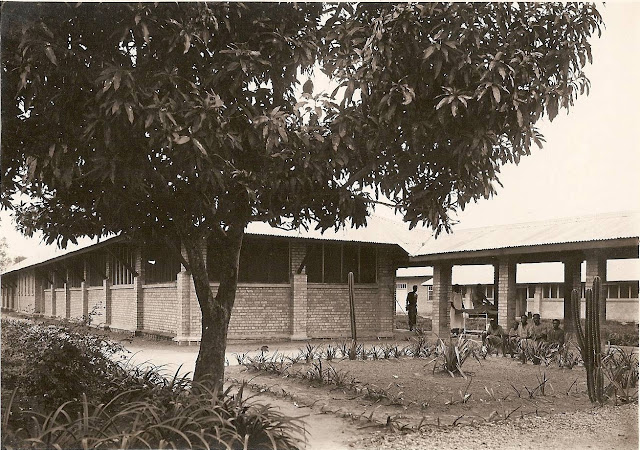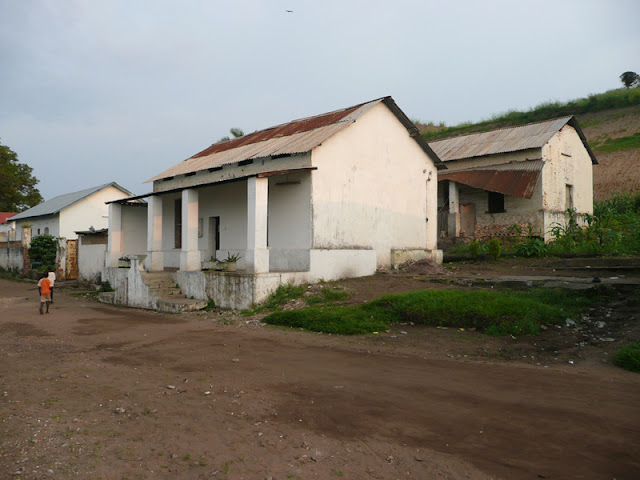| Image may be NSFW. Clik here to view.  |
| The first hospital for African - Hopital de la Rive |
The first hospital for Congolese opened in Leopoldville in 1902, built by Cdt. Mahieu along a strip of land downstream from the port between Mount Leopold and the rapids (See Mar. 5,2011). Considering the fact that the colonial settlement on Ngaliema Bay had been already been established for 20 years and the first hospital for Europeans was only created a decade earlier, it is important to understand that concern for the health of Congolese was closely linked to awareness that sick Africans could transmit their illnesses to the vulnerable European population. This perceived (though erroneous) threat represented the justification for the creation of “neutral zones” between the two communities (See July 31, 2011).
The two medical services continued to be closely linked, notwithstanding the segregation inherent in their respective operations, and played exemplary roles in delivering health care to the growing city. Dr. Gustave Dryepondt established the hospital for Europeans in 1891, in a paillote near the river. Six years later, the Association Congolaise et Africaine de la Croix Rouge (a charity founded by Leopold II in 1887), opened a hospital at the top of Mount Leopold on the Caravan Road.
| Image may be NSFW. Clik here to view.  |
| The Red Cross Hospital |
This was followed in 1899 by a Laboratoire Médicale established by Dr. Van Campenhout. (replaced the following year by Alphonse Broden). This complex became the foundation for medical services in Leopoldville and the wider urban area until the 1930s. The original laboratory was built on swampy ground near the Baptist Mission (SeeApr. 30, 2011)but was temporarily relocated to Boma while a new facility was being built adjacent to the hospital on the hill.
| Image may be NSFW. Clik here to view.  |
| The Bacteriological Laboratory - now Commune de Ngaliema |
Serious progress was made in expanding the hospital during 1906. US Consul Smith visited Leopoldville from Boma in August 1907, reporting, “decently constructed buildings” on the river below town. The patients were well-treated by a “skillful” physician interested in the work. In the same year, Dr. Jerome Rhodain joined Broden and took over the hospital and Lazaret. A new Lazaret was built on the Kilimani plateau above the river and connected to the town’s water supply.
| Image may be NSFW. Clik here to view.  |
| The Sleeping Sickness Lazaret |
| Image may be NSFW. Clik here to view. .jpg) |
| Interior of a lazaret |
| Image may be NSFW. Clik here to view. .jpg) |
| Tuberculosis camp |
| Image may be NSFW. Clik here to view. .jpg) |
| Entrance to the Hopital des Noirs in Kinshasa |
In 1920, Louise Pearce, an American researcher assigned by the Rockefeller Foundation arrived in Leopoldville to test tryparsamide as a treatment for sleeping sickness. She observed that the 3-room ground floor of the Laboratory was nearly finished; the equipment was fairly good, though there was no electricity. By 1922, the Laboratory was completed, although space was limited and plans were underway to move the facility to Kinshasa. A new doctor at the hospital in Kinshasa allowed Dr. Van Hoof to devote full time to the Laboratory. The following year, three new medical pavilions were opened next to the dispensary in Kinshasa.
| Image may be NSFW. Clik here to view. .jpg) |
| New wings in the Hopital de Noirs -- 1920s |
| Image may be NSFW. Clik here to view. .jpg) |
| Another view of the Hopital des Noirs -- 1920s |
The Kinshasa hospital was expanded in 1925 and modern radiology equipment was ordered. By 1926, the hospital had 192 beds for men and 48 for women and children. The following year, when a yellow fever epidemic threatened the city, the first cases of typhoid were also reported, suspected to have been transmitted by the opening of SABENA’s new air link to Elisabethville in Katanga.
| Image may be NSFW. Clik here to view. .jpg) |
| The dining hall |
During King Albert and Queen Elisabeth’s visit to the city in July 1928, the Queen urged that a more commodious medical facility be constructed for the European population. This led to a decision to construct a modern hospital in Kalina District, which became the Clinique Reine Elisabeth (August 5, 2011). At this point as well, plans were finalized to move the Laboratory to Kinshasa while the original Congolese hospital by the river became a facility treating lepers. The hospital in Kinshasa became the primary facility providing treatment to Congolese until the Kintambo hospital opened in 1958 (April 30, 2011).
| Image may be NSFW. Clik here to view. .jpg) |
| Queen Elisabeth visits the hospital -- 1928 |
| Image may be NSFW. Clik here to view. .jpg) |
| Hopital de la Rive -- 2010 |
| Image may be NSFW. Clik here to view. .jpg) |
| Commune de Ngaliema, formerly the Red Cross Hospital -- 2009 |
| Image may be NSFW. Clik here to view. .jpg) |
| Commune de Ngaliema, former Bacteriological Laboratory -- 2006 |
| Image may be NSFW. Clik here to view. .jpg) |
| Hopital General de Kinshasa, formerly Hopital des Noirs -- 2010 |
Sources:
· Foreign Relations of the United States, 1907, Vol.II.
· Janssens, Edouard, 1912. Les Belges au Congo, Vol III.
· Moulaert, Georges, 1948. Souvenirs d’Afrique.
· www.wikinshasa.com
.jpg)